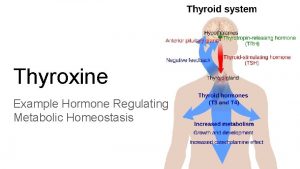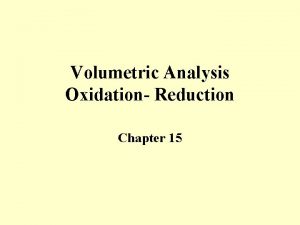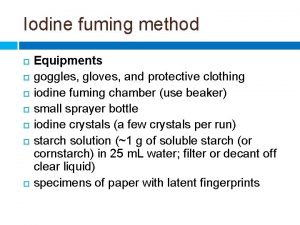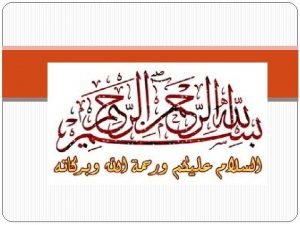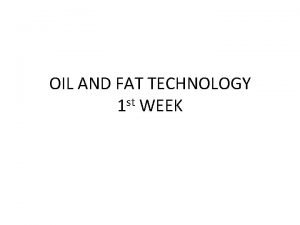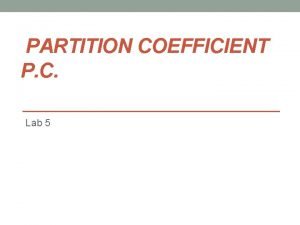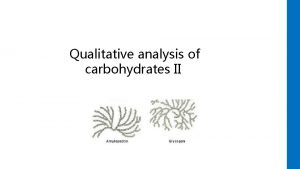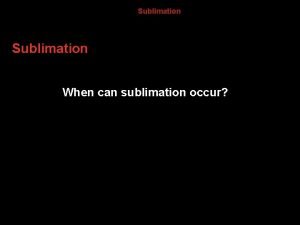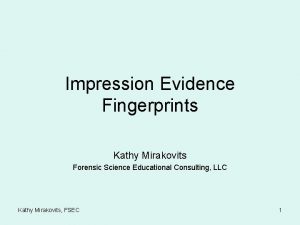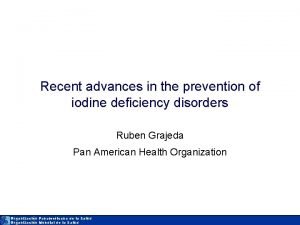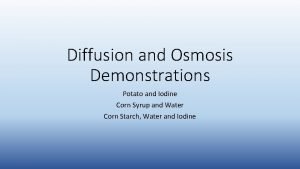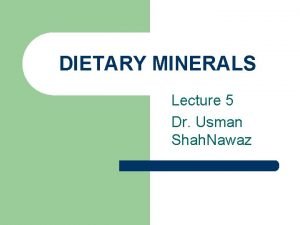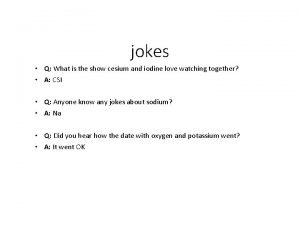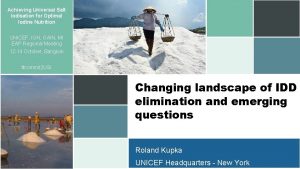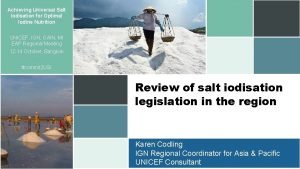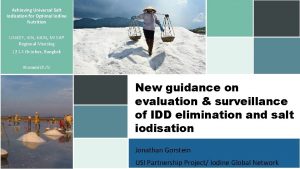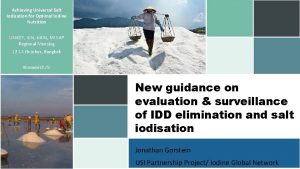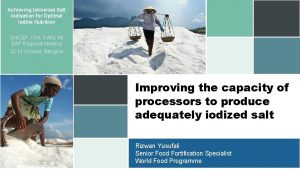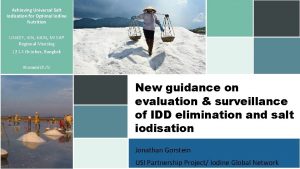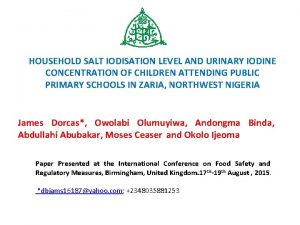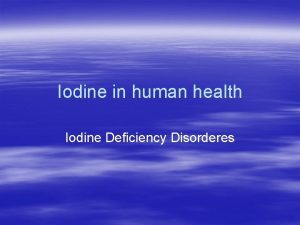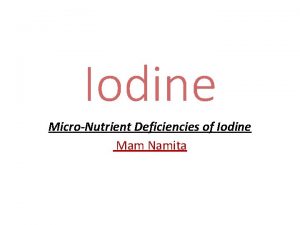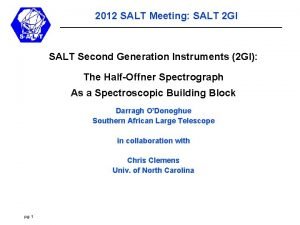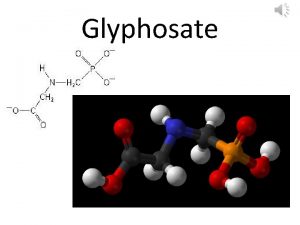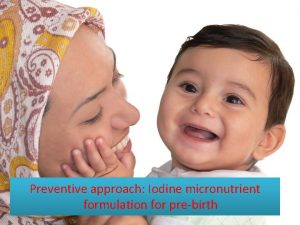Achieving Universal Salt Iodisation for Optimal Iodine Nutrition






















- Slides: 22

Achieving Universal Salt Iodisation for Optimal Iodine Nutrition UNICEF, IGN, GAIN, MI EAP Regional Meeting 12 -14 October, Bangkok Improving external and commercial monitoring of national fortification & USI programmes Greg S. Garrett, Director, Food Fortification, GAIN

AGENDA 1. Overview of common barriers and priorities for improving regulatory monitoring of USI/fortification programmes 2. Examples of ‘enablers’ to improve regulatory monitoring - Better information systems and use - A role for academia, civil society/media, retail - Laboratories 3. Summarizing the actors and priorities for improved regulatory monitoring 12 -14 October 2015 Bangkok EAP Regional Workshop on ACHIEVING UNIVERSAL SALT IODISATION FOR OPTIMAL IODINE NUTRITION 2

REGULATORY MONITORING WITHIN QA/QC LANDSCAPE Internal QA / QC Activities External QA / QC Activities Processing Industry Vehicles (Food) National or Imported Governments Vitamins Premix External Monitoring QA / QC Landscape Import of Fortified Food Processing, Fortification Factories or Packers Commercial Monitoring at Retail Stores Humanitarian Sector & Emergencies 12 -14 October 2015 Bangkok WHO Food Fortification Guidelines, 2006 EAP Regional Workshop on ACHIEVING UNIVERSAL SALT IODISATION FOR OPTIMAL IODINE NUTRITION 3

RECENT PUBLICATION HIGHLIGHTING BARRIERS AS WELL AS GOOD PRACTICES IN REGULATORY MONITORING § Publication draws conclusions from: –QA/QC data from over 20 countries –Results from a literature review and key information interviews with 11 fortification experts from program implementers, industry, and government. –Questionnaire responses completed by regulatory agencies in 15 countries and from food processing industry in 13 countries. A total of 17 countries were represented 12 -14 October 2015 Bangkok EAP Regional Workshop on ACHIEVING UNIVERSAL SALT IODISATION FOR OPTIMAL IODINE NUTRITION 4

ISSUE OF COMPLIANCE: THERE WILL BE LIMITED HEALTH IMPACT OF USI PROGRAMS IF SALT IS NOT IODIZED ACCORDING TO NATIONAL STANDARDS § Strong indication of non-fortified and under-fortified foods among products claiming to be fortified. Consider: § Monitoring data on GAIN’s grants and projects (staple and condiment fortification including USI) in 25 countries, show that fortification occurs within the mandated range just under 50% in all tests. Most samples underfortified or not fortified § This average serves only as an inference but indicates a systemic problem with compliance § There are non-fortified foods labelled as fortified thus misleading consumers on vitamin and mineral content. What’s worse, is there will be limited health impact of fortification programs when foods are not adequately fortified 12 -14 October 2015 Bangkok EAP Regional Workshop on ACHIEVING UNIVERSAL SALT IODISATION FOR OPTIMAL IODINE NUTRITION 5

CITED BARRIERS TO ENSURING COMPLIANCE: GOVERNMENT Industry 12 -14 October 2015 Bangkok Government • Low priority and capacity for enforcement. • Minimal harmonization of standards and legislation. • Limited funding. • Limited personnel for legal action. • Corruption among inspection personnel. • Poor laboratory capacity. • Limited training in rapid testing methods. EAP Regional Workshop on ACHIEVING UNIVERSAL SALT IODISATION FOR OPTIMAL IODINE NUTRITION 6

CITED BARRIERS TO ENSURING COMPLIANCE: INDUSTRY Industry 12 -14 October 2015 Bangkok Government • Poor quality or unsafe inputs. • Poor processing procedures and expertise. • Lack of SOPs and documentation. • Lack of adequate internal laboratory capacity. • Improper packaging and handling. • Lack of awareness of standards. • Purposeful under-fortification EAP Regional Workshop on ACHIEVING UNIVERSAL SALT IODISATION FOR OPTIMAL IODINE NUTRITION 7

WHAT ARE CITED PRIORITIES FOR IMPROVEMENTS TO ENSURE COMPLIANT FORTIFICATION & IODIZATION? Regulatory Agencies 71% 60% Food Industries 70% 57% 55% 50% 45% 43% 36% 35% 29% 30% 21% 20% 10% 7% 0% Clearer Clear regulations 12 -14 October 2015 Bangkok Reg. agency structure capacity financing Laboratory capacity Sampling/ testing procedures Food industry engagement Enforcement Communication (incentives/ b/w sectors penalties) EAP Regional Workshop on ACHIEVING UNIVERSAL SALT IODISATION FOR OPTIMAL IODINE NUTRITION 8

PRIORITY: INSPECTIONS AND ENFORCEMENT – A LYNCHPIN TO SUCCESS Incentives and penalties are widely used, but over 60% did not consider these to be particularly effective. Over 60% of all respondents perceived a political risk surrounding strong and consistent enforcement. • Fear of strike threats or resistance from interest groups. • Unwillingness due to insufficient resources required to navigate bureaucratic systems. • Reports of corruption or collusion between inspectors and industry. 12 -14 October 2015 Bangkok Results in inconsistent followthrough and lack of effective enforcement strategies EAP Regional Workshop on ACHIEVING UNIVERSAL SALT IODISATION FOR OPTIMAL IODINE NUTRITION 9

PRIORITY: MORE COST-EFFECTIVE USE OF RESOURCES AND/OR MORE FUNDING 82% of survey respondents noted their current funding is not sustainable over the next 5 years for regulatory monitoring Stretched Limited Budgets: Use audits more wisely Generate revenue through inspection, licensing, and testing services Use civil society, consumer, or industry groups to assist with monitoring activities 12 -14 October 2015 Bangkok Sustained government funding + use of that funding effectively coupled in some cased with greater funding is required to improve regulatory monitoring. Public-private partnerships can also be leveraged as key drivers of capacity strengthening, trust building, and funding for continued improvements. EAP Regional Workshop on ACHIEVING UNIVERSAL SALT IODISATION FOR OPTIMAL IODINE NUTRITION 10

ENABLER 1: BETTER INFORMATION SYSTEMS Where does the data go? How is it collated? How is it reported back and how is it used for decision making and action? § Need for a tool or system to allow manager to quickly understand where data gaps and noncompliance exist so action can be taken before impact is measure § Is there a data integration system? § Can reports be generated in a quick and easy format that allows for effective action, reporting? 12 -14 October 2015 Bangkok EAP Regional Workshop on ACHIEVING UNIVERSAL SALT IODISATION FOR OPTIMAL IODINE NUTRITION 11

EGYPT & INDIA– BETTER INFORMATION SYSTEMS § Background: Large, countries. No system for data. Egypt: Wheat flour used for baladi bread fortified with ferrous sulphate and folate. USI used for bread. India: iodized salt § Objective: Develop systems which aid government to assure the quality of the fortified wheat and iodized salt, with limited resources and make decisions. § Method: Introduce online monitoring system which generates a set of automated alerts in cases of outliers from the normal fortification range, premix stock unavailability and any other disturbance of the system. Track over time. § Results: online monitoring system fortification developed in 2010 for Egypt and in 2012 for India. Compliance data has continually improved. In 2013 since introduction, latest compliance data showing 95% of flour samples fortified at optimal levels or above. In India compliance improved by 5% on salt. § Conclusion: Implementing better systems for data collection and use by government is essential in resource constrained settings 12 -14 October 2015 Bangkok 12

ENABLER 2 - A ROLE FOR CIVIL SOCIETY/ACADEMIA/MEDIA AND RETAIL TO SUPPORT REGULATORY MONITORING? Fortified foods are credence goods. - One way to distinguish is branding. - Another way is to correct the knowledge imbalance. Civil Society and retail can play a strong role to enable government and industry to effectively deliver on their respective roles in ensuring quality iodization: - A powerful watchdog to protect consumers and improving consumer awareness through information campaigns - Test product at the market - Name/shame, name/praise by publicizing compliance/non-compliant brands 12 -14 October 2015 Bangkok EAP Regional Workshop on ACHIEVING UNIVERSAL SALT IODISATION FOR OPTIMAL IODINE NUTRITION 13

INDEPENDENT COMPLIANCE SURVEYS: NIGERIA ACADEMIA § Background: Food fortification mandatory since 2002. However, low levels of adequate fortification. GAIN and local university led independence market -based survey to test fortification levels. § Objectives: 1) ascertain levels of compliance for vitamin A and iron specified by the Standards Organization of Nigeria; and 2) use results as an advocacy tool to improve compliance and regulatory monitoring. § Results: Vitamin A compliance levels for sugar, oil, flour were 26. 2%, 24. 3%, 10. 2% respectively. Iron compliance in flour was 37. 8%. Vitamin A fortification guideline dropped from 10 mg/kg RE to 2 mg/kg RE. Iron standard being addressed. Internal and external QA/QC training facilitated. § Conclusion: Compliance studies can be used to inform government and industry stakeholders of the status of food fortification efforts and help guide programs toward improved health impact. 12 -14 October 2015 Bangkok 14

INDEPENDENT COMPLIANCE SURVEYS: SOUTH AFRICA – WORKING WITH CONSUMER GROUP AND MEDIA § Background: In 2008, well-established fortification program but continued high rates of child malnutrition. § Objectives: Consumer forum to undertake a market-based survey of fortification levels. § Methods: Sample maize meal products from supermarket shelves for laboratory testing of vitamin A, riboflavin, iron and niacin. § Results: National Consumer Forum found brands of maize meal not adequately fortified to meet requirements. Following the publishing of results, positive momentum was created allowing both industry and the food authorities to work towards improving fortification levels. § Conclusion: Consumer groups/associations and media can create positive pressure to improve compliance 12 -14 October 2015 Bangkok 15

CAN RETAIL HELP REGULATE? KYRGYZSTAN § Background : In 2005, Kyrgyzstan had low coverage of iodized salt on market (e. g. 60%) and poor government regulatory monitoring systems § Objectives: Empower retail and village health committees to test salt and drive non-iodized salt out of the market § Methods: distribute test kits and train retail and communities to verify presence of iodine in salt § Results: from 60 -90% percent iodized salt coverage in two years – sustained and based on retail strategy (published results). Non-iodizers pushed out of market. Government continues to support purchase of test kits for retail and health village committees annually § Conclusion: Retail self-regulation can be an effective approach to drive compliance forward, especially where consumer awareness is high and government monitoring systems are lacking 12 -14 October 2015 Bangkok 16

ENABLER 3: LABORATORIES REQUIRE GREATER RESOURCES AND CAPACITY The lack of laboratory capacity slows the testing process and prohibits inspectors from making cost-efficient judgments about required followup action. 38% report a lack of equipment and inputs for laboratories 50% report a lack of trained staff and technical capacity Competing regulatory priorities put pressure on limited human resources, equipment, and consumables. “The greatest challenge is getting test results acted upon!” 12 -14 October 2015 Bangkok EAP Regional Workshop on ACHIEVING UNIVERSAL SALT IODISATION FOR OPTIMAL IODINE NUTRITION 17

STRONG LABS: EXAMPLE OF MI SUPPORT TO SMALL SCALE PROCESSORS AND LABS IN INDONESIA (I/III) The issues: § Bima and East Lombok are salt producing districts of West Nusa Tenggara Province, (NTB) eastern part of Indonesia. § There was no salt iodization industry in this area. § But both districts produce about 60, 000 MT/year raw salt. § 30, 000 MT absorbed by large salt processors in Java island. § Remaining 30, 000 MT was leaking to the market for consumption within NTB and neighboring provinces of Bali, Nusa Tenggara Timur, South Sulawesi and Maluku. 12 -14 October 2015 Bangkok EAP Regional Workshop on ACHIEVING UNIVERSAL SALT IODISATION FOR OPTIMAL IODINE NUTRITION 18

MI-SUPPORTED MINI LABORATORIES AND QUALITY ASSURANCE (II/III) § PURPOSE: Develop capacity of District Industry and Trade Offices to monitor production and quality of iodized salt in line with regulatory requirements. § 30 Mini labs established 2012 -14 at district offices of Ministries of Industry and Trade Offices; § Equipment, chemicals, and training support provided § Staff conducted analysis of salt samples to determine iodine content and facilitate corrective actions. 12 -14 October 2015 Bangkok 19

RESULTS OF MI’S SUPPORT TO LABS (III/III) § Overall, iodization levels increased from 57% to 78 % [production level monitoring data] § Implementation of proper salt pond management –resulted in better quality and productivity of raw salt production in Bima and Lombok. § 2 Iodization Service Centres established as business entities to provide services to group farmers and salt producers. § Groups of salt farmers started producing labeled iodized salt and selling to government program and local market. § Local government capacity has been developed to monitor the quantity and quality of iodized salt. 12 -14 October 2015 Bangkok EAP Regional Workshop on ACHIEVING UNIVERSAL SALT IODISATION FOR OPTIMAL IODINE NUTRITION 20

III REGULATORY MONITORING: SUMMARIZING THE PRIORITIES AND THE ENABLERS Enforcement Financial and Human Capacity Better Data Capture & Use Political Will Legislation 12 -14 October 2015 Bangkok Civil Society Improved Regulatory Monitoring Relationshi p Building EAP Regional Workshop on ACHIEVING UNIVERSAL SALT IODISATION FOR OPTIMAL IODINE NUTRITION 21

Thank you! #Commit 2 USI
 Iodine deficiency
Iodine deficiency Iodine dns tunnel tutorial
Iodine dns tunnel tutorial Schulze's test for cellulose
Schulze's test for cellulose Redox volumetric analysis
Redox volumetric analysis Fehling's test sucrose
Fehling's test sucrose Half-life of iodine 125
Half-life of iodine 125 Pre natal sex
Pre natal sex Iodine dns tunnel tutorial
Iodine dns tunnel tutorial Iodine fuming chamber
Iodine fuming chamber Lugols iodine composition
Lugols iodine composition Iodine number calculation formula
Iodine number calculation formula Iodine fuming definition
Iodine fuming definition Disadvantages of iodine fuming
Disadvantages of iodine fuming Iodine partition coefficient
Iodine partition coefficient Qualitative analysis of carbohydrates
Qualitative analysis of carbohydrates Iodine sublimation temperature
Iodine sublimation temperature Iodine fuming
Iodine fuming Iodine deficiency
Iodine deficiency Half life
Half life Chlorine, iodine, and _____ make up the halogen triad.
Chlorine, iodine, and _____ make up the halogen triad. Potato and iodine diffusion experiment
Potato and iodine diffusion experiment Iodine functions
Iodine functions What is an ion
What is an ion
